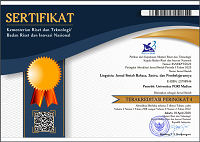Student’s voices on Kahoot at tertitary level in East Kalimantan
Abstract
The learning experience that motivates students can be created where competence is quantitatively assessed using gamification technology. A survey of students' opinions of gamification was conducted to determine the best practices of its use, the environmental conditions necessary for its success, and the manner in which the application should proceed. The effects of gamification on math achievement were examined using quantitative methods. The Kahoot application was found to be the preferred method of gamification in this study. These 80 English students took part in the experiment and studied at the Department. The findings revealed that adding gamification to the course increased the overall interest of students and boosted the aspirations of students to succeed in the course. This method also has a strong impact on the motivation of students. What this study found was that Kahoot can be used to successfully gamify lessons. In my research, the gamification method led to greater engagement by students.
Keywords
Full Text:
PDFReferences
Bergin, S., & Reilly, R. (2005). The influence of motivation and comfort-level on learning to program. http://mural.maynoothuniversity.ie/8685/
Bosworth, A. (2012). Keas: developing a successful game-based employee wellness program. Games for Health: Research, Development, and Clinical Applications, 1(3), 189-191. https://doi.org/https://doi.org/10.1089/g4h.2012.0020
Cavanagh, M. (2011). Students’ experiences of active engagement through cooperative learning activities in lectures. Active learning in higher education, 12(1), 23-33. https://doi.org/https://doi.org/10.1177/1469787410387724
Clark, R. C., & Mayer, R. E. (2016). E-learning and the science of instruction: Proven guidelines for consumers and designers of multimedia learning. john Wiley & sons.
Dellos, R. (2015). Kahoot! A digital game resource for learning. International Journal of instructional technology and distance learning, 12(4), 49-52. http://citeseerx.ist.psu.edu/viewdoc/download?doi=10.1.1.694.5955&rep=rep1&type=pdf#page=53
Deterding, S., Dixon, D., Khaled, R., & Nacke, L. (2011). From game design elements to gamefulness. u: Proceedings of the 15th International Academic MindTrek Conference on Envisioning Future Media Environments-MindTrek'11. New York: Association for Computing Machinery (ACM), str, 9.
Guller, C., & Guller, E. (2015). Gamification in online learning environment: the use of badge. Journal of Research in Education and Teaching, 4(3), 125-130. http://www.jret.org/FileUpload/ks281142/File/16b.can_guler.pdf
Hamari, J., Koivisto, J., & Pakkanen, T. (2014). Do persuasive technologies persuade?-a review of empirical studies. International conference on persuasive technology,
Hamari, J., Koivisto, J., & Sarsa, H. (2014). Does gamification work?--a literature review of empirical studies on gamification. 2014 47th Hawaii international conference on system sciences,
Hanus, M. D., & Fox, J. (2015). Assessing the effects of gamification in the classroom: A longitudinal study on intrinsic motivation, social comparison, satisfaction, effort, and academic performance. Computers & education, 80, 152-161. https://doi.org/https://doi.org/10.1016/j.compedu.2014.08.019
Huckabee, I., & Bissette, T. (2014). Learning made fun. Training Industry Magazine, 32.
Icard, S. (2014). Educational technology best practices. International Journal of instructional technology and distance learning, 11(3), 37-41. https://citeseerx.ist.psu.edu/viewdoc/download?doi=10.1.1.653.8946&rep=rep1&type=pdf#page=41
Kapp, K. M. (2012). The gamification of learning and instruction: game-based methods and strategies for training and education. John Wiley & Sons.
Kuo, M.-S., & Chuang, T.-Y. (2016). How gamification motivates visits and engagement for online academic dissemination–An empirical study. Computers in Human Behavior, 55, 16-27. https://doi.org/https://doi.org/10.1016/j.chb.2015.08.025
Lantz, M. E. (2010). The use of ‘clickers’ in the classroom: Teaching innovation or merely an amusing novelty? Computers in Human Behavior, 26(4), 556-561. https://doi.org/https://doi.org/10.1016/j.chb.2010.02.014
Mayer, R. E., Stull, A., DeLeeuw, K., Almeroth, K., Bimber, B., Chun, D.,
Bulger, M., Campbell, J., Knight, A., & Zhang, H. (2009). Clickers in college classrooms: Fostering learning with questioning methods in large lecture classes. Contemporary educational psychology, 34(1), 51-57. https://doi.org/https://doi.org/10.1016/j.cedpsych.2008.04.002
McGonigal, J. (2011). Reality is broken: Why games make us better and how they can change the world. Penguin.
Muntean, C. I. (2011). Raising engagement in e-learning through gamification. Proc. 6th international conference on virtual learning ICVL,
Okaz, A. A. (2015). Integrating blended learning in higher education. Procedia-Social and Behavioral Sciences, 186, 600-603. https://doi.org/https://doi.org/10.1016/j.sbspro.2015.04.086
Prince, M. (2004). Does active learning work? A review of the research. Journal of engineering education, 93(3), 223-231. https://doi.org/ https://doi.org/10.1002/j.2168-9830.2004.tb00809.x
Raymer, R. (2013). The Rock Stars of eLearning: An interview with Karl Kapp. eLearn, 2013(9). https://doi.org/https://doi.org/10.1145/2524222.2524223
Sanmugam, M., Zaid, N. M., Abdullah, Z., Aris, B., Mohamed, H., & van der Meijden, H. (2016). The impacts of infusing game elements and gamification in learning. 2016 IEEE 8th international conference on engineering education (ICEED),
Stowell, J. R., & Nelson, J. M. (2007). Benefits of electronic audience response systems on student participation, learning, and emotion. Teaching of psychology, 34(4), 253-258. https://doi.org/https://doi.org/10.1080/00986280701700391
Turan, Z., & GÖKTAŞ, Y. (2015). A new approach in higher education: The students’ views on flipped classroom method. Journal of Higher Education and Science, 5(2), 156-164. https://doi.org/https://doi.org/10.5961/jhes.2015.118
Wolff, M., Wagner, M. J., Poznanski, S., Schiller, J., & Santen, S. (2015). Not another boring lecture: engaging learners with active learning techniques. The Journal of emergency medicine, 48(1), 85-93. https://doi.org/https://doi.org/10.1016/j.jemermed.2014.09.010
Article Metrics
Abstract has been read : 269 timesPDF file viewed/downloaded: 0 times
DOI: http://doi.org/10.25273/linguista.v5i1.9464
Refbacks
- There are currently no refbacks.
Linguista: Jurnal Ilmiah Bahasa, Sastra, dan Pembelajarannya indexed by:
View My Stats








